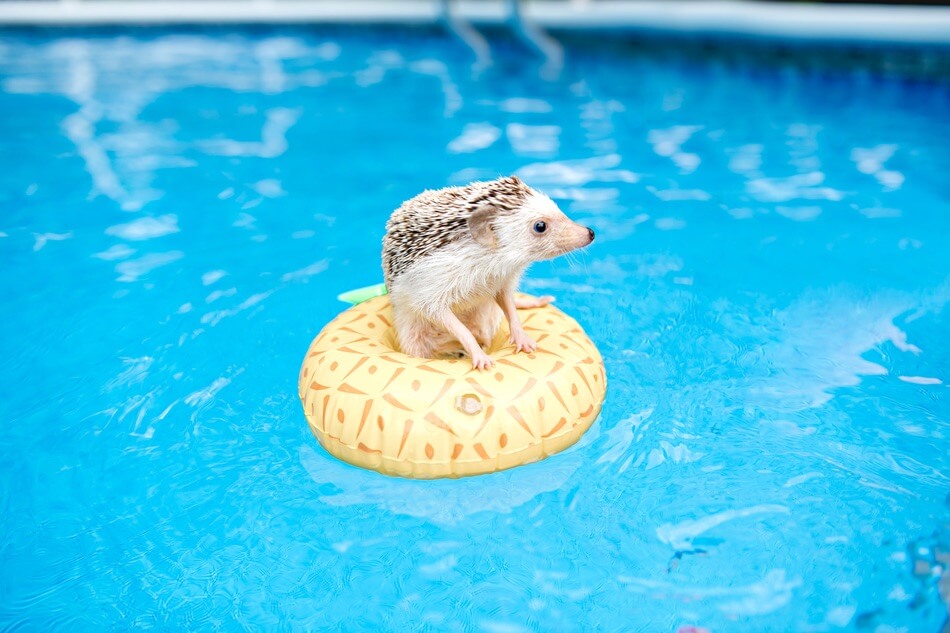“Can hedgehogs swim?” is probably one of the most common questions we get from potential new owners.
And the answer is a bit trickier than it seems.
This resource will help you understand everything you need to know about the swimming capabilities (and preferences) of hedgehogs.
Table of Contents
Can Hedgehogs Swim?
Even though hedgehogs make great pets and are becoming more popular, many owners are unsure of their swimming capabilities.
These animals are small, but they are covered with spiky quills that are filled with air. This helps to make them float should they enter water.
So in general, the answer is yes! Most hedgehogs are able to swim well. However, that doesn’t rule out the risk of this vulnerable creature becoming hurt or dying if they cannot climb back out of a steep pool or bank. They may hit their head or otherwise be injured as another possible negative scenario.
In their native habitats, hedgehogs are known as good swimmers. Since those quills are partially filled with air pockets, this creates a buoyancy that allows the creature to float and swim. Remember, without the quills, your little hedgehog may not be big at all (a process you’ll understand more when they go through quilling). This makes it easier for them to float and swim with ease.
Now, this does not mean that your unassuming little pet will one day make it into the Olympics. All hedgehogs should potentially be able to swim, and the question remains whether they want to or not (more on that later).

Some breeds of hedgehogs are known to possess the ability to swim better than some others. The four most common swimming hedgehog breeds below include:
- European Hedgehog
- African Pygmy Hedgehog (this is by far the most common pet variety)
- Indian Long-Eared Hedgehog
- Egyptian Long-Eared Hedgehog
It should be noted here that there are some factors that can make swimming more difficult for some than others. These factors include the hedgehog’s weight, size, gender and breed.
Quick Note: Sleep can also be a factor here. If your pet hedgehog is tired they might not feel like swimming (and might even put up a fight if you try to make them float). We’ve all been there!
Do They Like It?
Alright, now that we have established that hedgehogs can swim, it’s time to gauge how much they enjoy it. Whether your hedgie will like the refreshing dip into the water will depend on the preference of your unique and personable pet.
When it comes to preference, it’s worth pointing out that some hedgehogs may be intimidated or afraid of the water due to a past bad experience. A hedgehog may become stressed just because of the unknown factors in this new situation. These fears will generally keep these hedgehogs on land. That said, other hedgehogs will dive right in without any issues!
Another possible reason why your prickly one might not like swimming is that they are just lazy or grumpy for some unknown reason.
Hedgehogs do tend to be a bit cautious regarding swimming the first few times. So, do not be surprised if your hedgie shakes, quivers, arches up its prickly back or poops right there in the pool or other water source. All these things are fairly common.
Is It Safe to Let Them Swim?
In general, the answer here is yes, but you should never leave your pet hedgehog alone while he is swimming. Make sure that there is some sort of ramp where your pet can climb up on when he wants to get out of the water. It’s also nice to have a floating platform for when your little hedgie gets tired and wishes to take a break or warm up a bit.
It is important to know that even hedgehogs that like to swim can drown if they get into trouble. Avoid leaving them alone where there is a deep pool or garden water feature where the sides are higher making it difficult for your short and sweet hedgehog to climb out when ready. It is best to cover any garden pool or other water source at night if your hedgehog will be playing outside. This can help prevent any accidents.
Another potential danger when your hedgehog is swimming outside is nearby wildlife and/or other neighborhood pets that may try to attack your little pal. Hedgehogs will freeze and roll onto their backs when feeling threatened. When in water, their air filled quills counteract this attempt.
Even the best swimmers among hedgehogs can get tired easily from this exercise. Eventually they will become too fatigued and exhausted, and this is a situation that may cause your pet extreme harm if they’re not being supervised carefully.
The Advantages Of Letting Them Swim
There are a few advantages of letting your little hedgehog swim. First, swimming can be fun for your pet provided you give them enough time to get used to the water and always supervise him/her when in or near any water source. Swimming is a terrific source of exercise for your little pet. While yoga and spin classes may be out of the question for hedgehogs, most will get plenty of exercise by swimming on occasion.
Another fantastic benefit of letting your pet hedgie swim is that it stimulates their mind, body and spirit. Hedgehogs living in the wild tend to spend long hours foraging for food and trying to stay away from any predators nearby.
When in captivity, hedgehogs can get bored easily. This boredom can cause them to become depressed and they will sleep more often and eat more than they need at meals. This can result in the hedgehog gaining too much weight. Obese hedgehogs unfortunately are common for those kept as pets.
1. Fitness
Many hedgehog owners feed their pet foods that have too high of a fat content. Without enough regular exercise, those calories will add up and your bored and out-of-shape hedgie friend will gain weight and even become morbidly obese. This is never good for any small creature.
Adding some weekly or biweekly swimming into their routine can be an excellent method to encourage movement and activity. Always give your pet time to get fully used to the water first so they stay comfortable and look forward to swimming again in the future. Regular exercise and a nutritious and low-fat diet can keep your hedgehog feeling and looking fit and strong.
2. Enrichment
All pet hedgehogs need mental stimulation just like other pets do. Hedgehogs are instinctively on the alert when in the wild. However, when a hedgie is kept as a pet, this instinct can diminish, and your pet may become bored and restless. Swimming can give your pet hedgie enough mental stimulation to help prevent boredom and laziness from setting in.
Since most pet hedgehogs do not have to worry so much about a natural predator looking to make them its next meal, a hedgehog can let its guard down. Lack of motivation will become normal for your pet, and swimming every now and then can help keep your pet alert and mentally focused.
Owners of hedgies should also give their pets stimulating and fun toys to keep their interest and encourage them to move. Rotate the toys out to prevent boredom from becoming an issue. Make sure that any toy that you introduce to your hedgehog is safe for use with these little critters. Ask your vet if you are unsure.
Like dogs and other pets, hedgehogs will like playing games with their human family members. Swimming together can be a fun activity that enables your little prickly pet to be social as well. These kinds of activities can make your pet feel happy and fit.
Can Baby Hedgehogs Swim?
Baby hedgehogs can swim if they have the opportunity. Always allow them to get used to the water experience slowly and move forward at their own pace.
Most pet owners assume that baby and adult hedgehogs will need a bath to keep clean. However, this is not the case. Hedgehogs lick themselves clean, rather like a cat, and they spend a large portion of their day grooming themselves.
However, sometimes it may be necessary to give your hedgehog a bath if he has gotten into something that is exceptionally dirty, sticky or smelly.
Before allowing your baby pet to swim in a deeper amount of water, it is necessary to give them some time to build up strength. Young hedgehogs will need encouragement and a calm environment to pursue swimming lessons. Never just throw your hedgehog into the water. This can frighten them immensely and even cause serious health issues and stress.
Begin the process of swimming by filling a sink or bathtub with lukewarm water keeping the water depth very shallow. Gently allow your hedgehog to put its feet in the water as you hold them carefully (while also keeping them secure). If your hedgehog panics, take them out of the water and dry them off. Try to do your best to give them lots of support and assurance that all is well.
Quick Note: We should point out that baby hedgehogs that have never had the opportunity to swim before often kick and splash due to their fear. This is normal. Take this process slow and raise the water level a slight amount each time you take them for a swim.
At first, keep the water level low enough that your hedgehog can walk around without having to float or swim. If your baby hedgie does well with shallow water in a sink or low container, try introducing them to the bathtub next. If your pet still seems too anxious, wait a while until he grows into adulthood.
Should You Avoid Swimming Pools?
Hedgehogs can swim in swimming pools if you take the proper precautions. Always be right by your hedgehog and be careful not to splash chlorinated water into its eyes, ears or mouth. Have something in the water for your pet to climb onto if they want to just float and rest awhile.
The general rule to follow is to simply use caution when letting your hedgehog swim in your pool, and keep the swim sessions short. Also, only allow your hedgehog to swim in the pool every couple of weeks or so.
After your hedgehog is done having fun in the pool, rinse them off well with room temperature water. This will wash away any potentially irritating chlorine.
Too much chlorine can irritate your vulnerable hedgehog’s skin. Be especially careful around any pool equipment like the filter or heat pump in a warm water pool. These items can be dangerous to small pets like hedgehogs.
Hedgehogs should not be left in the care of a young child without an adult always present. This is for its overall safety and well-being.
Keep an eye on kids when your pet is inside of the pool. There should not be any nearby jumping and splashing since this can frighten your hedgehog and lead to serious anxiety and stress.
Hedgehogs can also swim in garden pools when they are well supervised. Some prefer to swim only inside in a tub or sink. Be mindful of how your pet reacts when introduced to these new water environments, and proceed slowly to lessen any stress or fears that your pet may have in these situations.
Most hedgehog experts recommend allowing your pet to swim about three to four times a month if they enjoy it. Limit the initial swimming session to 5 to 10 minutes. Lift your pet out of the water about every 30 seconds to a minute for a rest if they are in deeper water where they need to paddle, float or swim.
What Water Temperature Do They Prefer?
It is best to keep the water lukewarm no matter which type of water source your hedgehog will be swimming in. Water temperatures that are too hot or too cold can seriously harm your little one quickly. Always test the water temperature first before allowing your pet to get into it.
With the proper supervision and precautions, your hedgehog may learn to love swimming with their favorite owner staying nearby. Swimming can provide your pet with mental stimulation and overall exercise to keep your hedgehog safe, in shape and happy throughout its lifetime.





